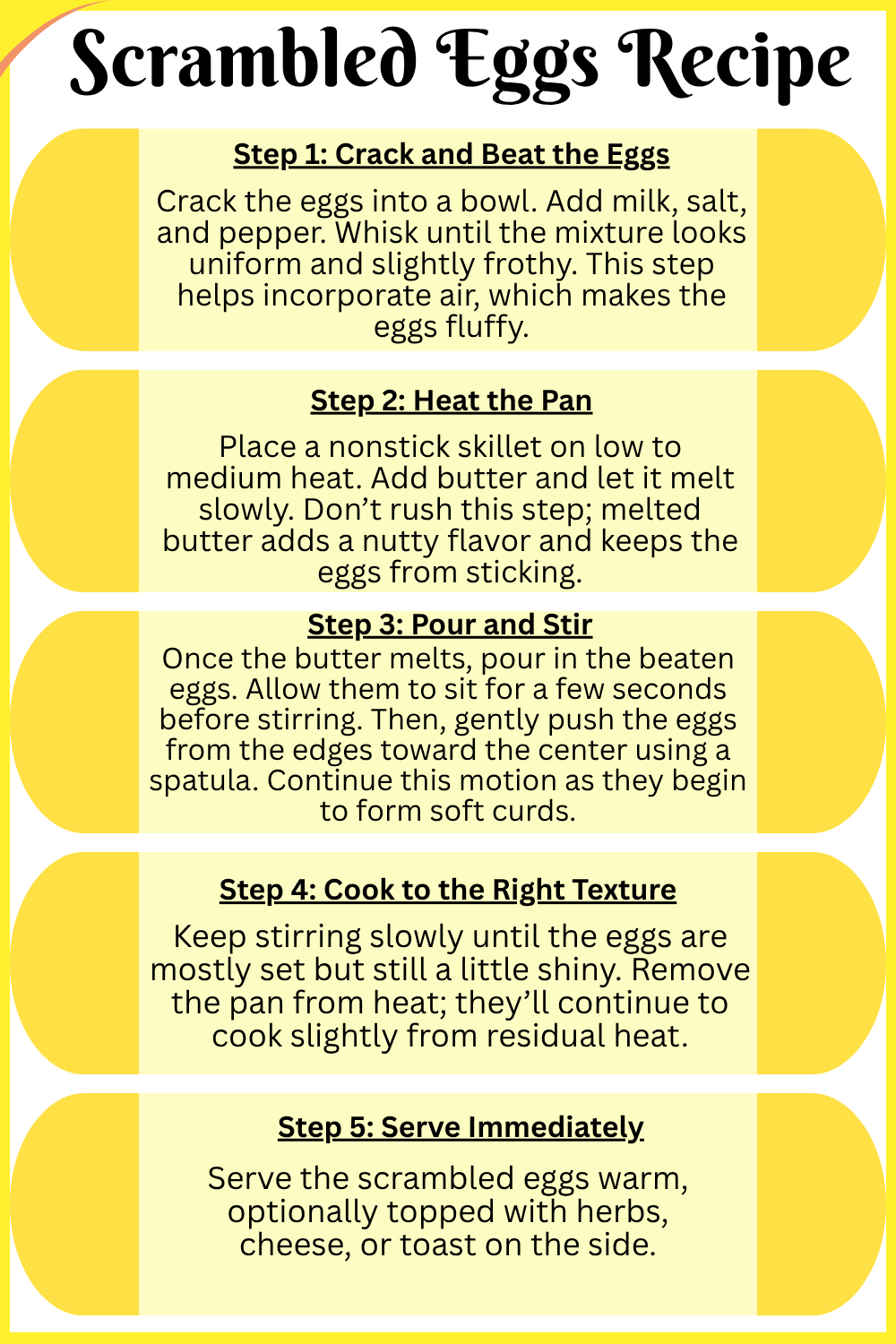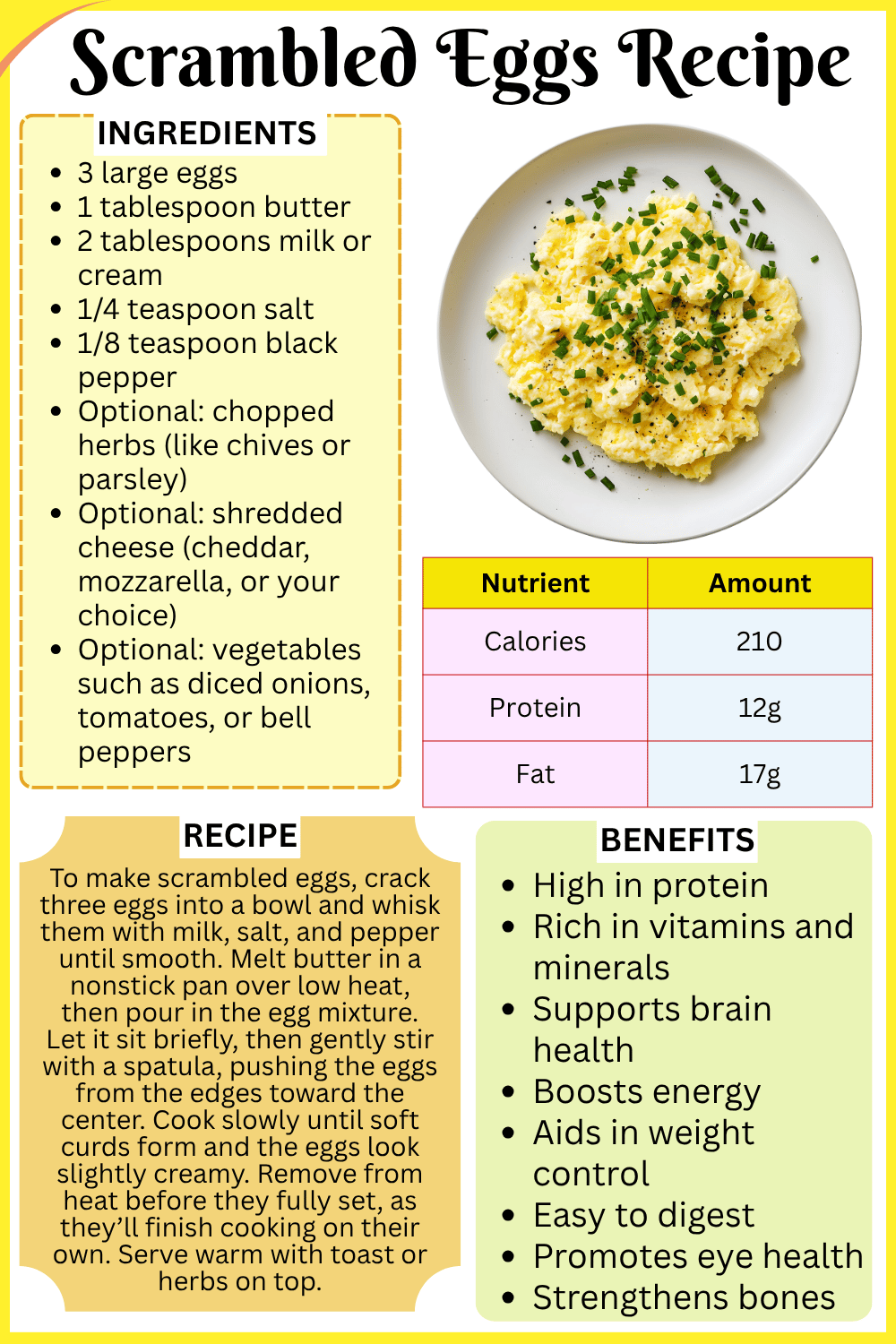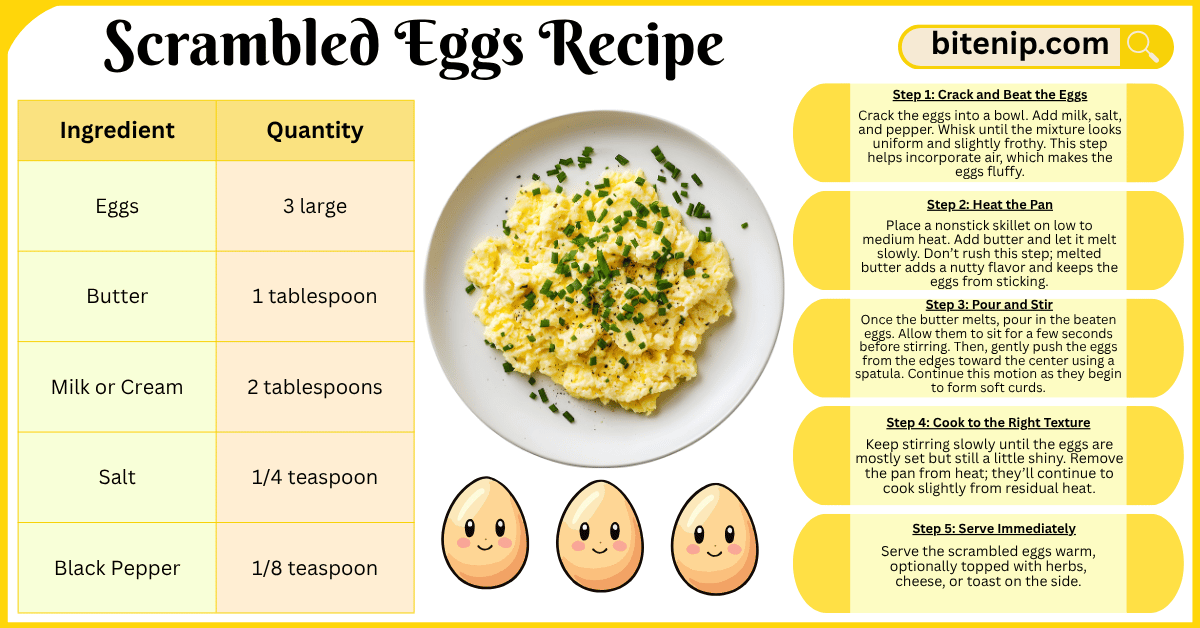Scrambled eggs are one of the easiest yet most comforting dishes you can make. They’re warm, fluffy, and satisfying, making them perfect for breakfast or brunch. Whether you enjoy them plain or with a touch of herbs and cheese, scrambled eggs always deliver a cozy start to your day. With a few simple techniques, you can turn basic eggs into a silky, restaurant-style meal that’s ready in minutes.
Origin of Scrambled Eggs
The origin of scrambled eggs goes back thousands of years. Ancient Romans were among the first to cook beaten eggs with milk or honey, a dish they called ovemellitum. Over time, this simple idea spread worldwide, becoming a breakfast staple in many cultures. Today, nearly every cuisine has its own version—some add butter and cream, while others mix in vegetables or meats. Despite regional twists, the heart of scrambled eggs remains the same: comfort in every bite.
Ingredients of Scrambled Eggs Recipe with Pictures
Each ingredient plays a key part in making scrambled eggs soft and flavorful. Here’s what you’ll need and why it matters:
- Eggs
The main ingredient, providing structure, protein, and rich taste.

- Butter
Adds a smooth texture and enhances flavor while preventing sticking.

- Milk or Cream
Creates a soft and fluffy texture by adding moisture.

- Salt
Balances flavor and brings out the natural richness of the eggs.

- Black Pepper
Adds a light kick that complements the eggs’ creaminess.

Ingredients with Quantities
| Ingredient | Quantity |
|---|---|
| Eggs | 3 large |
| Butter | 1 tablespoon |
| Milk or Cream | 2 tablespoons |
| Salt | 1/4 teaspoon |
| Black Pepper | 1/8 teaspoon |
Step by Step Scrambled Eggs Recipe
Step 1: Crack and Beat the Eggs
Crack the eggs into a bowl. Add milk, salt, and pepper. Whisk until the mixture looks uniform and slightly frothy. This step helps incorporate air, which makes the eggs fluffy.
Step 2: Heat the Pan
Place a nonstick skillet on low to medium heat. Add butter and let it melt slowly. Don’t rush this step; melted butter adds a nutty flavor and keeps the eggs from sticking.
Step 3: Pour and Stir
Once the butter melts, pour in the beaten eggs. Allow them to sit for a few seconds before stirring. Then, gently push the eggs from the edges toward the center using a spatula. Continue this motion as they begin to form soft curds.
Step 4: Cook to the Right Texture
Keep stirring slowly until the eggs are mostly set but still a little shiny. Remove the pan from heat; they’ll continue to cook slightly from residual heat.
Step 5: Serve Immediately
Serve the scrambled eggs warm, optionally topped with herbs, cheese, or toast on the side.

Common Mistakes to Avoid
Overcooking:
One of the biggest mistakes is cooking eggs too long. Overcooked eggs turn dry and rubbery. Always remove them from heat just before they look done; they’ll finish cooking on their own.
High Heat:
Using high heat may cook the eggs too quickly, causing uneven texture. Low to medium heat ensures they stay creamy and soft.
Skipping the Whisk:
Not beating the eggs properly can make them dense. Whisking adds air and helps achieve that fluffy texture everyone loves.
Not Using Butter or Oil:
Cooking without enough fat leads to sticking and dryness. A bit of butter gives your eggs richness and prevents burning.
Tips for Perfect Scrambled Eggs Recipe
Use Fresh Eggs:
Fresh eggs have a tighter structure, producing smoother and creamier curds.
Cook Slowly:
Patience is key. Slow cooking keeps the texture soft and prevents browning.
Add Dairy Wisely:
A splash of milk or cream adds tenderness, but too much can make the eggs watery.
Season at the Right Time:
Add salt before cooking so it dissolves evenly, enhancing flavor.
Variations of Scrambled Eggs Recipe
Cheesy Scrambled Eggs:
Add shredded cheddar or mozzarella near the end of cooking. The melted cheese creates a creamy, savory flavor.
Herb Scrambled Eggs:
Mix in fresh herbs like chives, parsley, or dill for a bright, fresh taste.
Vegetable Scrambled Eggs:
Add sautéed onions, tomatoes, or bell peppers for a more colorful and nutritious meal.
Spicy Scrambled Eggs:
Sprinkle in chili flakes or a dash of hot sauce for extra heat and flavor.
Serving Suggestions
Scrambled eggs pair beautifully with toast, hash browns, or a side of avocado. You can also serve them inside breakfast burritos or on top of buttered English muffins. A sprinkle of cheese or herbs adds color and flavor, making your plate look as good as it tastes.
Nutritional Information (Per Serving)
| Nutrient | Amount |
|---|---|
| Calories | 210 |
| Protein | 12g |
| Fat | 17g |
| Carbohydrates | 2g |
| Cholesterol | 370mg |
| Sodium | 290mg |
Why People Love Scrambled Eggs ?
People love scrambled eggs for their simplicity and comfort. They’re quick to make, yet endlessly versatile. From a plain breakfast to a full meal with vegetables and cheese, scrambled eggs can fit any taste or diet. Plus, they offer a creamy texture and rich flavor that few other breakfast foods can match.
Benefits of Scrambled Eggs Recipe
1. High in Protein
Scrambled eggs are an excellent source of high-quality protein. Protein helps repair body tissues, supports muscle growth, and keeps you feeling full for longer. This makes scrambled eggs a great choice for breakfast, especially if you want steady energy throughout the day.
2. Rich in Vitamins and Minerals
Eggs contain essential nutrients like vitamin A (for eye health), vitamin D (for bone strength), vitamin B12 (for brain function), and selenium (for immune support). These nutrients work together to keep your body functioning properly and reduce fatigue.
3. Supports Brain Health
Eggs are rich in choline, a nutrient that supports brain development and improves memory. Regular consumption of scrambled eggs may help maintain focus and mental clarity.
4. Good for Weight Management
Because scrambled eggs are filling and low in carbs, they help reduce unnecessary snacking. Eating them in the morning can keep hunger under control and support weight management goals.
5. Boosts Energy
The combination of protein and healthy fats in scrambled eggs provides steady energy without causing a sudden sugar spike. This helps you stay active and alert for hours after eating.
6. Improves Eye Health
Eggs contain antioxidants like lutein and zeaxanthin, which protect your eyes from harmful blue light and reduce the risk of cataracts and age-related vision loss.
7. Easy to Digest
Scrambled eggs are soft and easy on the stomach, making them suitable for people recovering from illness or those with digestive issues.
Disadvantages of Scrambled Eggs Recipe
1. High Cholesterol Content
Egg yolks are naturally high in cholesterol. While moderate consumption is safe for most people, eating too many eggs regularly may raise cholesterol levels for those who are sensitive or have heart problems.
2. Saturated Fat Concerns
Cooking scrambled eggs with butter or cream increases saturated fat intake. Over time, too much saturated fat can contribute to heart disease. Using olive oil or cooking spray is a healthier alternative.
3. Risk of Overconsumption
Because eggs are delicious and easy to prepare, it’s common to eat them too often. Consuming excessive amounts can lead to an imbalance in diet, especially if you’re not including enough fruits and vegetables.
4. Possible Allergies
Some people are allergic to eggs, especially children. Symptoms can range from mild itching to more serious reactions. It’s important to be aware of this if you’re cooking for others.
5. Food Safety Issues
If eggs are undercooked or left at room temperature for too long, they can carry bacteria like Salmonella. Always cook scrambled eggs thoroughly and refrigerate leftovers promptly to avoid foodborne illness.
6. Added Ingredients Can Make Them Unhealthy
Scrambled eggs can become less healthy when loaded with cheese, cream, or processed meats like bacon or sausage. These additions add extra calories and sodium, reducing the overall nutritional value.
FAQs
1. Can I make scrambled eggs without milk?
Yes. You can skip milk and still get creamy eggs by cooking them slowly on low heat.
2. What’s the best pan for scrambled eggs?
A nonstick skillet is ideal because it prevents sticking and makes stirring easier.
3. Should I add salt before or after cooking?
Add it before cooking so it blends evenly and enhances flavor.
4. Can I make scrambled eggs ahead of time?
They taste best fresh, but you can refrigerate leftovers for up to two days.
5. How can I make eggs fluffier?
Whisk thoroughly before cooking and use low heat to create soft curds.
6. Can I add cheese?
Yes. Add it near the end so it melts without clumping.
7. Why are my eggs watery?
They may be undercooked or contain too much milk. Reduce the liquid slightly next time.
8. How do I make them healthier?
Use olive oil instead of butter and add vegetables like spinach or tomatoes.
9. Can I freeze scrambled eggs?
Yes, but they may lose some texture. Store them in an airtight container.
10. What’s the secret to restaurant-style scrambled eggs?
Cook slowly, stir gently, and take them off the heat before they’re fully set.

Conclusion
Scrambled eggs are a timeless dish loved for their warmth, flavor, and simplicity. With just a few basic ingredients and a little care, you can make soft, creamy eggs every time. Whether enjoyed alone or with your favorite sides, they’re a satisfying meal that never goes out of style.
Learn More Helpful Article
